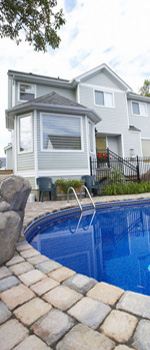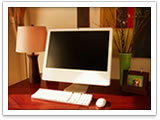
|
Follow Me On: |
 |
Kathleen Petty AVP/Sr Mortgage Originator Global Credit Union Home Loans AK#157293 Phone: (907)261-3458 Cell: 223-4440 Fax: (907)929-6699 License: NMLS Unique Identifier #203077 K.Petty@gcuhome.com https://www.globalcu.org/home-loans/resources/originators/Kathleen-Petty/ |
 | ||
| ||||
September 2007

|
Creating a Home Office
There are many rooms in a home that could be considered a sanctuary: a cozy bedroom, a luxurious bathroom, and a state-of-the-art home theater, to name a few. But, how about an office? We realize it's a bit of a stretch to equate a home office with a place of refuge, but maybe it's time we changed that. Why an Office? The aforementioned tasks, as well as countless others, require three conditions for successful completion: organization, technological function, and the ability to focus. Creating a home office is the perfect means for achieving all three. Very rarely can this be accomplished in random spots in the home. It is not unheard of for a home to a have one bedroom that is virtually unused. After all, many a "spare bedroom" contains nothing more than a foldout couch and a few miscellaneous boxes stacked against the wall. Rooms such as these may house an occasional guest or two, but on an everyday basis they are practically ignored. Why not hold on to that foldout, add a few essential pieces, and turn that room into an office that doubles as a spare bedroom? Another reason for creating a home office is the potential tax deduction. It is imperative, however, that you consult with a qualified tax professional on the matter. There are requirements and restrictions for using a home office as a write off. Doing so without the proper advice can be a huge red flag for the IRS. Lastly, by creating one room that houses all of your work, you simultaneously achieve greater organization in the rest of your home. All of the furniture, equipment, and materials that were once scattered around your home are now pulled into one location. Think of the free space this can create. Getting Started According to most architects, a home office should be no smaller than 10 feet by 10 feet. A room this size allows ample space for standard office equipment (i.e. desk, filing cabinet, bookcase, shelves, etc.) Other considerations for picking the perfect room are lighting, ventilation, and a lack of distractions. Not only are these all characteristics of an optimal work environment, their existence minimizes the purchase of equipment or furniture that can take up valuable space. Technology If you're undecided about the need for a certain item, hold off on buying it. In the meantime, create lists of the equipment and furniture you already have, the items you need to buy, and the items you may want to add in the future. These lists come in very handy when you're deciding on the layout of your office. Layout Instead, start by drawing a floor plan of your empty office. Use a 1-inch scale (one inch on paper to equal one foot of floor space), and be sure to include any doors, windows, and closets. Now, measure the furniture and equipment you already own, writing down the corresponding dimensions on your list. By using the Internet or visiting various office-supply stores, find the dimensions of the equipment you need to buy now, as well as the equipment you may want to purchase in the future. Note these dimensions on the appropriate lists as well. Once the measuring has been completed, you can start plotting where the individual pieces will be placed inside the room. Be sure to use a pencil as it may take experimenting with various layout combinations to figure out what works the best. It is during this plotting of the room's layout that you can determine your capability for future expansion. Be sure to write down your placement plans for any potential additions. Storage
Walls Lighting Large lights like floor lamps and ceiling lights should have the ability to be dimmed. In the case of any light controlled by a switch on the wall, replace the on/off switch with a dimmer control. They are relatively inexpensive, easy to install, and can be found at any hardware store. We urge you to carefully read the directions regarding shutting off the electricity prior to installation. Desk lights are really more about style than function, as most of them tend to work the same. What's important is to equip your desk light with a light bulb that's easy on the eyes. These "soft" light bulbs can be found anywhere, from office supply stores to grocery stores. The Contents Desk Chair Computer/Printer If space is an issue, think about purchasing a laptop computer as opposed to a desktop model. Newer laptops come in all shapes and sizes and have nearly all the capabilities of a desktop. The major differences are that desktops tend to be a little faster than laptops and easier to upgrade. If purchasing a printer, you may want to think about purchasing a combination printer. These are printers that also act as scanners and copiers, and, in some cases, even fax machines. This is a great way to save on space and money. Wall Organizers Miscellaneous Cord covers are a great way to not only hide cords but to keep them from becoming a tangled mess. They can be purchased quite cheaply at any electronics store. Inserts for desk drawers are handy for keeping the contents in order. In terms of your desktop, various caddies can be purchased which can house anything from Post-its® to paper clips. A hand-held label maker is another great tool for any home office. Whether you're labeling folders or storage boxes, printed labels look nicer and lead to better organization. Décor should not be overlooked. Certificates, diplomas, awards, trophies, and pictures not only complement an office, they also help to personalize it. We wish you good luck in creating your home office. Just think: organization, function, and focus could be right around the corner. And, if all goes well, your new office will be a place to work – and take refuge. | ||||||||||||||||||||||||||||||
License #AK157293 You are receiving a complimentary subscription to YOU Magazine as a result of your ongoing business relationship with Kathleen Petty. While beneficial to a wide audience, this information is also commercial in nature and it may contain advertising materials. INVITE A FRIEND to receive YOU Magazine. Please feel free to invite your friends and colleagues to subscribe. SUBSCRIBE to YOU Magazine. If you received this message from a friend, you can subscribe online. UNSUBSCRIBE: If you would like to stop receiving emails from Kathleen Petty, you can easily unsubscribe. Global Credit Union Home Loans AK#157293 |
, 125 W Dimond Blvd #110 Anchorage, AK 99515 Powered by Platinum Marketing © Copyright 2024. Vantage Production, LLC. | |||||||||


